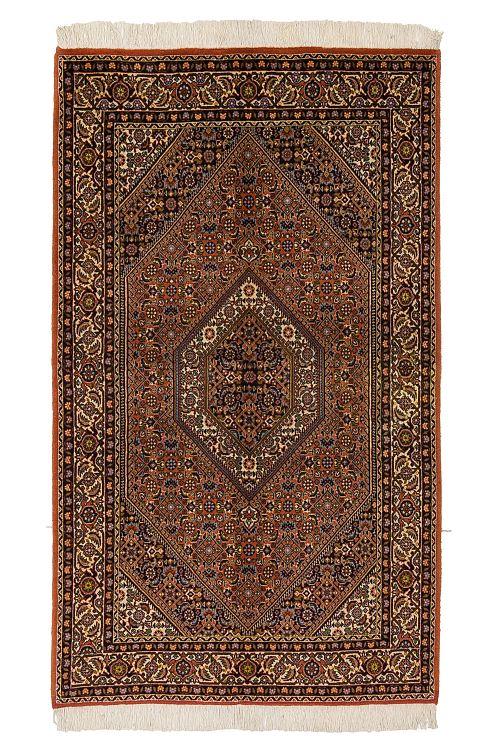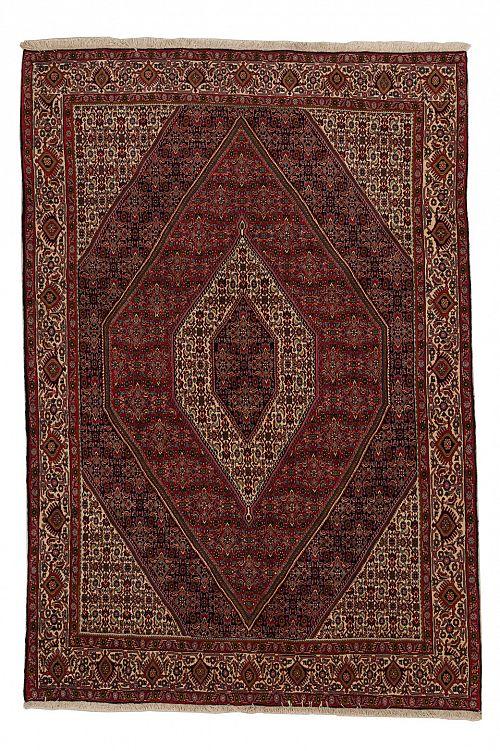Getting to know Takab handwoven carpet
Azerbaijan is one of the important centers of carpet production in Iran, and carpet weaving is common in most of its cities and villages. The products of this art are very important in terms of export, one of the most famous carpet areas in this province is Takab city, and Afshar Takab carpet is world famous. In this article, we are going to introduce you to Afshar Takab carpet and its unique features.
Takab and its historical record
Takab means a narrow water and a land with low and narrow water flowing in it. Takab, a compound noun, means a land valley where water sinks in some places and rises in other places. Takab city has dozens of historical monuments from before Islam. Including Takht Suleiman, which is located forty-two kilometers northeast of Takab and is the center of the great Sasanian fire temple called Azargashseb, one of the three famous Sasanian fire temples. Probably, the city of Takab was located in this place at first, which was destroyed due to the activity of Mount Zandan volcano, one and a half kilometers away from the current Takht Suleiman, and traces of it remained.
Background of carpet weaving in Takab
Archeological evidence in West Azarbaijan province confirms that Haft Khan designs with a map including many flowers, which are woven in all regions of Afshar, were popular in the distant past. In recent years, in the archaeological excavations of Qalaichi Bukan hill, some bricks have been unearthed, which according to the excavator, Mr. Bahman Kargar, belongs to the 7th century BC. These motifs are painted on the patterned bricks and the use of this pattern so far may be a proof of the long history of artists' connection with this design. As a result of the passage of time, these designs have reached the current periods from generation to generation, which include the same designs seen in bricks. These designs include types of eight-petaled flowers with a circular core, which are called Haft Khan designs only in the same region. The movement of the designs in the carpet is 3, 4, and 6, and in the middle of them, rhombuses are placed to create a distance between the designs. Combined subjects of flowers and mirrors move linearly along the horizon lines. The mentioned designs have been seen in the same way on the exposed bricks in Bukan with the mirrors removed. Glazed designs including six-petal decorative flowers with a central core that are on one side or on two adjacent sides that were used in the corners are abundantly obtained from this place. The mentioned designs are exactly the same as Haft Khan's designs which have been traditionally from the first millennium to this time.
Afshar Takab carpet
Afshar's exquisite and precious carpets and rugs are particularly popular in the world carpet markets and have the best quality in terms of color, quality, texture and design. Sometimes its carpets are so delicately woven by the skilled women and girls of Afshar that it can be placed in a handbag. But due to the neglect of the parents of the former governments over many years, the artistic and industrial products of this region at any point in time were called one of the cities in terms of country or geographical divisions that had no connection with each other, such as Bijar, Zanjan, Hamedan and sometimes Maragheh and Tabriz is provided. It should be noted that the map and colors of Afshar's carpet are inspired by the maps of other parts of Azerbaijan, especially Tabriz. Because the business and trade that brought cream, paint and map to Tkabak was imported from Tabriz and is still imported from there.
Color in Afshar Takab carpet
If we want to get enough information about the vegetable dyes used in Afshar carpets, we should listen to the old dyers and the owners of the large Tabriz carpet weaving workshops. This industry is simply so complicated that only the dyer in Sarkham Rangarzi can tell which color he is getting for the customer. In any case, all these colors are called color cup or color pot; Because these colors were prepared inside Khem or Koop or Kazan. Kazan means pot in Turkish.

How to prepare different colors of Afshar Takab carpet
- Laki Ronasi
In this dyeing process, runas are pounded and soaked in water with wool, and they sleep in a coop or kham for two days, and then they boil them completely until their color is fixed. From this lacquer or red color, they prepare several other types of lacquer or red colors according to the taste and initiative of dyers.
- Facial
In this type of dyeing, first the runas are pounded and cooked in a bend, then the wool is soaked and boiled in the bend (but it boils less than the varnish color), then it is left in buttermilk for an hour or two until the color becomes transparent.
- yellow
They take this from a desert plant called Jashir, whose local name is "Jarmand" or "Jashort". That is, according to the above instructions, the end is placed in a bend, then boiled, and some cow urine is added to it to stabilize the color.
- Pink or onion color
This color is prepared from Runas, and the amount of time for boiling the Runas cream is one day or less, and finally, it depends on the taste and accuracy of the dyer and the customer's wishes. In this dyeing, buttermilk is also used for stability.
- Walnut
To prepare this color, they beat the walnut skin and pour it inside the bend. Then they are boiled with cream inside Khem. From this type of walnut color, two or three types of strong, medium and weak walnut color are obtained with a catalyst such as buttermilk, lime or hydro.
- green color
This color is also made from Jashir plant and a type of "gandel" plant by adding other materials such as lime and hydro according to the customer's request.
- Navy color
This color was made from indigo, which was imported from Germany. To prepare this color, indigo was laid in a cup or khem, and after boiling, hydro and lime were used to stabilize the color.
- Cream
The cream color, whose local term is "colored gordach", is obtained from a special type of cream that, according to most dyers, is mostly cultivated in Germany.
- Black color
Black color is obtained from pomegranate peel or from rusty iron by sleeping in a coop and adding other materials. In addition, garlic gray and light gray colors are prepared from this mixture by adding other materials such as hydro and lime.
Technical features of Afshar Takab handwoven carpets
- Most of the genuine Afshar rugs have a thread count between 15 and 25 rows. Therefore, Afshar Takab carpets are placed in the coarse weave category in terms of texture.
- Turkish knot is the only knot they use. Unlike the Afshar nomads, other weavers from other Afshar clans use Persian knots in their carpets. At present, some of the carpets that are woven under the name of Afshar carpet in the villages of Sirjan suburbs have Persian knots.
- All nomadic carpets of Kerman province, including Afshar and other nomads, always weave Shirazeh carpets. Carpet payment is done among all the nomads of Kerman province when it is woven.
- The use of ground dars is one of the most important features of nomadic carpets in Kerman province.
- Chelekashi is usually done on the dar and in Turkish style.
- Nomadic carpets of this province were single weft in the past, but now they are woven in thin and thick two wefts. Red weft is another characteristic of Asil Afshar carpets.
- Afshar carpet weaving is generally Persian style using thick weft.
The world fame of Afshar Takab carpets
When it comes to Takab handicrafts, Zarin Afshar carpet comes to mind, which has a worldwide reputation. The art and industry that the people of Takab have lived with, have given it life and made it eternal. In Takab Afshar city, after agriculture and animal husbandry, carpet weaving is considered the most important profession and source of people's income. Due to its unique beauty and quality, especially strength and durability, Afshar carpets have a reputation beyond the borders of Iran and are considered one of the most exquisite carpets in the world. . The special texture and the way of beating Afshar rugs have made it known as metal carpet.
The style of the ridges, the way of weaving and other technical specifications related to the Afshar Takab carpet
The style of the ridges depends on the rug and raw materials of the carpet. In the Afshar region, the knot is of the Turkish type, where the weaver ties the knot twice with her fingers. Turkish knot is considered one of the special features of Afshar carpet, although this type of knot increases the consumption of cream in the carpet, so that about ten kilograms of cream is used in one square meter of Afshar carpet, but this makes the Afshar carpet strong and durable. will be
The most important carpet weavers of Afshar Takab
Afshar carpet is a folk art that has been born from the heart of Afshar region of Azerbaijan for thousands of years and thousands of people have worked hard for its continuity and development. This carpet is a relic of the ancestors of the people of Afshar region of Azerbaijan, which has evolved over thousands of years and reached the peak of beauty. The people of the region have lived with this art, kept it alive and immortalized it. But among the most important contemporary servants of Afshar carpets, we can mention Jiran Khanim, Abu Talib Khan Afshar, Amir Makram, Sardar Afshar, who had centralized carpet weaving workshops before the Islamic revolution, and people such as Ahmad Bahramian, Ezzat al-Taqvi, Yeganeh, Nusrat al-Kshavarz, Azari and Rahmati have decentralized carpet weaving workshops. Currently, Mr. Soleimani, Yousufianpour and Sharifi have active carpet weaving workshops in Takab.
Conclusion
Afshar Takab carpet is one of the exquisite and authentic Iranian carpets, which is world famous due to its unique quality and unparalleled beauty. The motifs of these carpets have ancient roots in the culture and beliefs of the people of Takab region and they tell the beliefs of one of the noble Iranian tribes.
You can inquire about Buying Handwoven Carpets , Buying Handwoven Kilim and Mats , and Buying Handwoven Pictorial Rug Tableaus online from the Hoveida Carpet Store and register all your orders and Wherever you are in the world, deliver it to the desired address in less than 4 working days.
If you are interested in reading other articles in the field of Handwoven carpets or Handwoven Pictorial Rug Tableaus , please refer to Hoveida Carpet Commercial .
Leave a comment
Your email address will not be published. Required fields are marked *












